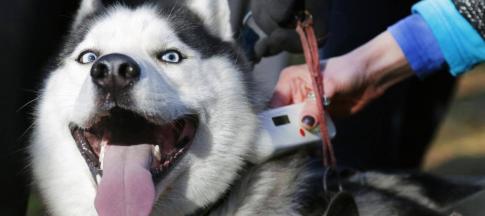
Pets being left in hot cars throughout the summer months is an issue that hits news headlines every year.
Here, we'll discuss how to drive safely with pets in the car while following the Highway Code.
The dangers of leaving your pet in a hot car
The RSPCA found that, if the temperature outside is 22°C, it'll reach 47°C in a car within an hour.
Dogs, cats and other pets who are left in cars without enough ventilation or water can suffer from dehydration, heatstroke and even death.
In June 2024, the British Veterinary Association reported that reported cases of heat stroke in dogs increase by five times in very hot weather.
It isn't illegal to leave your pet in a hot car in the UK. But under the 2006 Animal Welfare Act, a pet owner may be charged with an animal cruelty offence if their pet dies in a hot car while in their care.
Follow some simple tips to make sure your pet is both safe and happy in the car on hot days.
Travelling with your dog or cat in summer
To keep your pet safe in the car on hot and humid days, you should:
- keep one or more windows slightly open to improve ventilation
- use the air conditioning instead of or alongside slightly open windows
- take regular breaks so your pet can get some fresh air and stretch their legs
- give them food and water where possible
- give them any comforting additions, like their favourite toys
- pack some emergency supplies (extra food and water, medication, etc.)
- always make sure they're safely and comfortably restrained in the car, whether that's a spacious cage or seatbelt harness
- consider the difficulty of getting larger breeds back to your home or car in warmer temperatures
Keeping your pet safe out of the car
There are a lot of ways heat can harm your pet even when they’re not in a car.
In 2024, we teamed up with PawSquad to bring you some important statistics about the dangers to your pet during hot days. Here’s what we found.
It's important to note that tarmac can reach very high temperatures on hot days, as shown below:
| Time of day (GMT) | Air temperature (°C) | Tarmac temperature (°C) |
|---|---|---|
| 10:00 | 21.4 | 39.0 |
| 12:00 | 23.6 | 48.2 |
| 14:00 | 24.9 | 45.1 |
| 16:00 | 25.1 | 50.0 |
Research from the University of Leicester, in partnership with Admiral, shows the dangers of hot surfaces. It was found that the surface temperature of tarmac is much higher than the air temperature reaching 50°C - more than double the air temperature.
PawSquad also reported high numbers of queries during summer months for blisters, difficulty walking and extreme panting.
Additional tips for preventing overheating in pets
There are additional preventive measures that can be taken by pet owners to keep their pets safe. Below Nicki Fox RVN CertVNECC, Admiral’s Veterinary Specialist, shares her top tips for this summer:
Know the signs
Familiarise yourself with the signs of heatstroke, such as heavy panting and difficulty breathing, drooling, lethargy, vomiting and collapse. We’ll discuss heatstroke in more detail a little later.
Plan ahead
Don't venture too far from home and make sure you walk in the shade and on grass where possible. Stay within easy reach of water if you can.
Avoid the hottest weather
Avoid walking during the hottest parts of the day. Try to go out before 8am and after 8pm during particularly hot spells of weather.
Take it easy
According to research by The Kennel Club, over-exercising or exercising your dog on hot days accounts for around 75% of cases heatstroke.
Other common causes include not being able to cope in hot weather (around 13% of cases), being in a hot vehicle (around 5%) and being in a hot building (around 3%).
If you’re taking your pet outside, remember to:
- take water with you – for you and your pet!
- have your phone on you - (fully charged) in case of emergencies
- consider attaching a lead to a harness rather than to their collar - leads that pull on a collar can press on their airways and stop them from cooling down as easily
Remember: Dogs don't sweat like people do - they have small sweat glands on the pads of their paws, but this doesn't make a lot of difference when they try to cool down.
You may notice your dog panting. This is another dog cooling technique that can work but is not hugely effective. Dogs are not very efficient when it comes to cooling down.
Which dogs are more at risk of heatstroke?
All dogs are different, so a dog’s reaction to heat often depends on things like:
- age
- breed
- existing health conditions
It’s best to constantly keep an eye on your dog when out in hot weather to make sure they’re okay.
The bigger the dog could mean the bigger the risk.
Veterinary surgeon Dr Mark Boddy, CEO of PawSquad, adds that the risk of overheating is much higher for larger breeds.
You may need to consider the difficulty of getting larger breeds back to your home or car in warmer temperatures. PawSquad advises large dog owners are more cautious once it hits 21°C, and 23°C for medium and small dog breeds.
Following the Highway Code
There's a Highway Code rule on pet car safety that applies regardless of the weather conditions. Rule 57 of the Highway Code says:
"When in a vehicle, make sure dogs or other animals are suitably restrained so they cannot distract you while you are driving or injure you, or themselves, if you stop quickly. A seat belt harness, pet carrier, dog cage or dog guard are ways of restraining animals in cars."
Even if your pet is timid or small, you still need to keep them restrained in some way to stop them from distracting you while you're driving.
Does driving with a pet affect your insurance claims?
If you get into a road accident while driving with your pet in the car, your Admiral car insurance claim may be affected based on whether you were following the law.
If your pet wasn't restrained and was distracting you at the time of the crash, this could affect your claim.
Your Admiral car insurance policy won't cover any injuries your pet might suffer in a car accident. For that, you'll need pet insurance.
We offer pet insurance for dogs and cats only. If you have more than one pet, check out our Multi Pet insurance.
What to do if you see a pet locked in a hot car
If the pet seems like they're okay, take these steps:
- Write down the car’s make, model and number plate number.
- Consider ringing the helpline of your local pet charity for support.
- Stay with the pet until the owner returns.
- If you're in a hotel, restaurant or shopping centre car park, you could talk to a staff member to see if they can let the owner know about the situation.
- If you're suspicious of the owner and think the pet is still in danger, call the police via your local department's non-emergency line on 101.
If you see a pet that looks distressed, take these steps:
- Call 999 if the pet is unconscious, breathing or panting heavily, vomiting, or lethargic - these are all signs of heatstroke.
- Wait for the police to arrive to safely enter the car and recover the pet.
- If you feel you need to break into the car to free the pet, remember that you could be criminally charged for damaging someone else's vehicle.
- Tell the police before breaking into the car if you've decided you need to.
- Get the contact details of any witnesses who can vouch for your reason for breaking into the car.
Signs of heatstroke
To keep an eye out for heatstroke in cats and dogs, you can follow our HOTDOG acronym:
- Heavy panting and / or breathing distress
- Only urinating in small amounts
- Tremors, seizures or collapse
- Drooling, dizziness or diarrhoea
- Overtiredness and / or agitation
- Gums that are red or very pale
Dr Mark Boddy has some useful advice on how best to help your dog if they’re overheating:
“If you suspect heatstroke, move your pet to a cooler area, offer them a drink of water, and use cool water to dampen their body. Fan them gently.
“Don’t cool your dog too quickly by putting them in freezing cold water as this can actually have the opposite effect. You could try using a wet towel (for short periods only) to cool your dog, which is fine for short periods.
“As a dog’s body temperature slowly rises, it causes damage to the tissues and organs. In severe cases, heatstroke can cause their organs to fail which leads to death. Even if your pet seems better, call your vet straight away to ensure there are no underlying issues.
“By being proactive and attentive, you can spare your pet from the dangers of heatstroke. Your furry friend's well-being is worth every precaution.”


